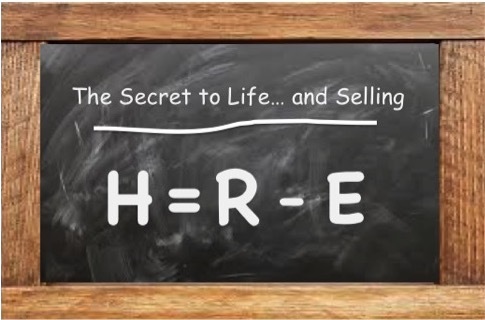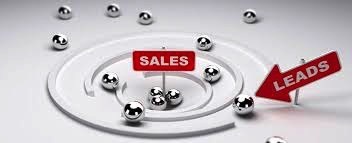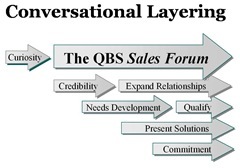Thomas A. Freese's Blog, page 8
September 19, 2016
The Secret to Life…and Selling

What if the secret to being successful in sales (and in life) could be boiled down into a simple mathematical formula that would apply to all your dealings, both personal and professional? Well, it can be. Here it is:
H = R – E
Happiness (H) equals the difference between expectations (E) and reality (R).
If you think about it, whenever you (or the product or service you deliver) falls short of the customer’s expectations, you will more than likely have an unhappy customer. Fortunately, the opposite is true. If you consistently exceed expectations, then you will likely have many happy customer relationships.
A salesperson cannot always control reality (R), however. When a shipment gets delayed, a product malfunctions, or some other mishap occurs, those things can cause the customer a great deal of angst. They can cause sellers a great deal of angst as well, particularly if competitive vendors are nipping at your heels in important accounts.
Like the bumper sticker says, “Stuff Happens!”
Consequently, my clients sometimes ask, “What’s the best way to recover when the sales process goes awry?” Ironically, there is no single “best way,” as most sales are situationally dependent.
But, rather than just sit back and hope everything goes well, the key to being successful in life (and in sales) is to be proactive in your dealings with customers. Being proactive gives sellers an opportunity to minimize the number of things that could go wrong.
For example, when I sold superservers for NetFrame Systems, every box was a custom order. So, by the time the decision maker got around to signing a purchase order, it wasn’t unusual for them to declare that they need it to be implemented… “Yesterday!” That sort of demand from the customer sets in motion a whole flurry of escalation activity and calls to speed up the typical 14 day manufacturing process.
Well, guess what happens when you “hurry” the manufacturing process of a highly sophisticated, precisely engineered product? Yep, quality can suffer, and all kinds of oversight issues enter into the equation that otherwise wouldn’t have. Even if the salesperson is able to pull the proverbial rabbit out of a hat in order to deliver on the customer’s harried expectations, the vendor usually doesn’t get credit for extra effort—because they are simply delivering on what the customer expected.
Rather than continually trying to move mountains, I recommend focusing more on proactively managing the customer’s expectations, rather than burning unnecessary cycles to deliver on unrealistic expectations. So, first and foremost, I would ask, “Mr. Customer, what are you expecting with regard to ____________?” It’s quite possible their expectations are already in line with your ability to deliver, in which case, there’s no need to promise the moon and the stars in an attempt to earn their business.
Trust me, every customer who signed a P.O. for $200,000 to purchase a superserver was sure to ask, “How soon can we get the product installed?” My response—“To be safe, you should plan on a lead-time of 30 days.” In fact, rather than waiting for customers to ask about delivery, I made it a point to set their expectations in advance.
Of course, when the customer’s NetFrame arrived in two weeks (the usual lead-time for delivery), I would call the customer and let them know that… “I was able to pull some strings and get their box sooner than expected.” Of course, they were happy (H), because reality (R) exceed their expectations (E). Even when the build took three or four weeks, customers were just as happy, because the expectation had been set that they should plan on 30 days.
In sales, as in life, we can’t always control reality, but there are many opportunities to proactively manage the expectations of your customers, your colleagues, your boss, your children, your spouse, and anyone else who expects you to deliver as promised.
August 19, 2016
Traditional Relationship-Building is Overrated
 Being outgoing, gregarious, and friendly used to be the savvy salesperson’s ticket to penetrating new accounts. Today, key decision makers on your target list of prospects already have plenty of friends. And, given the sheer volume of solicitations that come in on a daily basis, it shouldn’t surprise anyone that the next cold call that gets lobbed in the customer’s direction has only a very small chance of success.
Being outgoing, gregarious, and friendly used to be the savvy salesperson’s ticket to penetrating new accounts. Today, key decision makers on your target list of prospects already have plenty of friends. And, given the sheer volume of solicitations that come in on a daily basis, it shouldn’t surprise anyone that the next cold call that gets lobbed in the customer’s direction has only a very small chance of success.
Some of the reason sellers are experiencing such low hit-rates is self-inflicted, by using traditional catch-phrases like, “I would love to…”, or, “I just need a brief moment of your time.” Decision makers know you’re not just looking for a brief moment of their time. They also assume salespeople have quotas to hit and would really “love” to boost their commissions.
No doubt your intentions are good, as most salespeople are earnestly trying to provide value to their customers. The challenge is separating yourself from the countless other solicitations potential buyers receive on a daily basis, and then causing decision makers to “want to” engage with you.
Suppose if it were possible to reverse this trend. What if you could create an 80%+ success rate when reaching out to new prospects, rather than continue enduring the typical 90%+ failure rate? How is this possible, you might ask?
Acquiring the skills necessary to fill your pipeline faster, and with more qualified prospects, is actually easier than one might think. But, it does require sellers to have an appreciation of next-generation selling skills, which is very different than just trying to ‘buddy’ your way into potential opportunities.
There’s no magic, and God knows old-school sales tricks or gimmicks aren’t going to work moving forward. Instead, there are a few very important questions individual sellers (and entire sales teams) should be asking themselves, like:
• What are you doing to leverage curiosity to get mindshare from key decision makers in target accounts?
• What Diagnostic Questions™ are you asking to convey credibility?
• How does opening with a generic elevator pitch differentiate you from competitors who are making similar claims?
• What are you doing to secure incremental commitments on the way to the larger sale?
When you’re on the receiving end of cold calls at home, I bet you’re not excited about giving information to people you don’t yet know and trust. So, why should we expect the old-school mentality of trying to “befriend” prospective customers, if that strategy no longer works on you or me? Hmmm…
August 3, 2016
2016 QBS Fall Boot Camp: Oct 4 – 5
 “There has never been a better time for sellers to do everything possible to make themselves invaluable to their customers, colleagues, and their company.” -T. Freese
“There has never been a better time for sellers to do everything possible to make themselves invaluable to their customers, colleagues, and their company.” -T. Freese
We are excited to announce the upcoming 2016 QBS Fall Boot Camp! If you would like to renew your focus on increasing your own sales effectiveness, or give your entire sales team an unfair advantage over the competition, join us on October 4 – 5, 2016.
The program will be facilitated by five-time best-selling author Tom Freese.
The learning environment will be highly interactive, with participants from a variety of industries including technology, financial services, healthcare, consulting, insurance, real estate, manufacturing, advertising, hospitality, and retail, and feedback from previous QBS Summit events has been “off the charts.”
With limited seating, reserve your seats early since we are expecting a full house. You might also want to bring extra pencils and a stack of writing pads for note taking.
“Tom! I wanted to thank you for an amazing training two weeks ago-my head is still spinning from all of the great info. I met with our Regional Manager yesterday and he wants you to train the rest of our team. You will be hearing from us very soon…” -Liz B., Michigan…your newest QBS groupie!
July 7, 2016
Effective Sales Coaching Requires More Than Just Tracking Deals
Throughout my pilgrimage in developing and training the QBS Methodology, I have always totally supported the notion of qualifying prospect opportunities, in order to know how to best allocate your available sales resources and proactively manage the sales forecast. But, just asking a bunch of qualifying questions to track deals on the forecast hardly qualifies as effective sales coaching.
It turn out that the tracking questions sales managers tend to ask over the years hasn’t changed much, as it’s no surprise that the goal is to try and discern where various opportunities stand, in addition to understanding what needs to happen to further the sales cycle, and ultimately consummate a business transaction.
Typical sales tracking questions include:
Who is the primary decision maker?
What’s their timeframe for making a decision?
Who else needs to be involved in the discussion?
What are the prospect’s primary business drivers?
How much is the projected deal worth?
What are the potential next steps in their evaluation?
Which competitors pose the greatest threat?
Is there any way to close the business sooner?
The answers to these questions are valuable in terms of strategically targeting the efforts of the sales team. However, this line of questioning does little to help sellers know how to execute more effectively. You will also notice that while these questions help to track the status of prospect opportunities, just asking a bunch of “status” questions provides little value to the customer.
Understanding the status of a forecasted deal is not coaching. Using a sports analogy, when a manager’s only focus is asking a series of questions to track the status of various deals, that’s the equivalent of a football coach showing up in the locker room after a game, and asking questions to find out what happened during the actual contest.
 True coaching, whether we’re using a sports analogy or actually talking about selling, is a proactive exercise to make sure individual players (or your entire team) are prepared to execute as effectively as possible. Thus, in Chapter 3 of my recently released book (SalesForce 2020), I have catalogued a series of coaching questions we use in Question Based Selling to cause salespeople (and managers alike) to think more deeply about specific objectives for upcoming calls, and how exactly they plan to accomplish those goals.
True coaching, whether we’re using a sports analogy or actually talking about selling, is a proactive exercise to make sure individual players (or your entire team) are prepared to execute as effectively as possible. Thus, in Chapter 3 of my recently released book (SalesForce 2020), I have catalogued a series of coaching questions we use in Question Based Selling to cause salespeople (and managers alike) to think more deeply about specific objectives for upcoming calls, and how exactly they plan to accomplish those goals.
Here a few examples of what proactive coaching questions sound like:
How many reasons do you want customers to have to buy from you?
What’s your strategy for gaining credibility early in the call?
What’s your strategy for causing prospects to “want to” share information with a salesperson they don’t yet know or trust?
What are you doing to leverage curiosity in the sales process?
What makes you purposeful and relevant in the eyes of a customer?
Will you be perceived as customer-focused or self-serving?
How will you differentiate yourself from all the competitive reps who are out there calling your same list of target accounts?
Ultimately, the most productive form of coaching is self-coaching—having the awareness (in advance) to know how to handle various sales situations, knowing that your sales manager isn’t always going to be available to tell you what to say.
What do I mean by self-coaching? Here is yet another list of proactive sales questions that sellers should consistently be asking themselves.
What advantages do I have over competitive options, including the decision to do nothing or maintain the status quo?
If I repeatedly get a prospect’s voice-mail, what message can I leave that will cause them to become curious enough to “want to” return my call?
What business issues or decision factors am I prepared to raise (that otherwise may not come up) in my next customer conversation?
How can I create mini-invitations that will lower the prospect’s natural defenses and help propel opportunities forward?
Which Diagnostic Questions™ am I going to use to kick-off my next needs development conversations?
How can I position our solutions as the most cost-effective alternative that accomplishes the customer’s objectives?
How can I close for a commitment or suggest possible next steps without sounding pushy or self-serving?
How can I help internal champions secure the necessary approvals from their counterparts or manager, especially if I’m not in the meeting?
What could I do to be more effective than on my last customer call?
 Notice that these self-coaching questions are all scripted in the first person? With all there is to consider about coaching sales teams or empowering yourself on how to be more effective, my philosophy on skills development is actually pretty straightforward. This is not the time to sit back and wait for someone else to make you successful. There is plenty of guidance available to sellers, in the form of books, audio programs, and live sales training courses. But, do pick wisely, as I’ve made a career out of un-teaching traditional sales approaches, instead showing salespeople and sales organizations how to separate themselves from older-school paradigms that have been touted for decades, but no longer apply in the real world.
Notice that these self-coaching questions are all scripted in the first person? With all there is to consider about coaching sales teams or empowering yourself on how to be more effective, my philosophy on skills development is actually pretty straightforward. This is not the time to sit back and wait for someone else to make you successful. There is plenty of guidance available to sellers, in the form of books, audio programs, and live sales training courses. But, do pick wisely, as I’ve made a career out of un-teaching traditional sales approaches, instead showing salespeople and sales organizations how to separate themselves from older-school paradigms that have been touted for decades, but no longer apply in the real world.
And, since it’s impossible to earn a PhD in sales from your favorite university, it’s incumbent on top performers to focus on those things that will produce the greatest return on invested sales effort (ROISE). This includes becoming a student of “how” to more effectively execute each of the steps in your company’s coveted sales process.
(This is an excerpt from Chapter 3 in Tom Freese’s new book, SalesForce 2020.)
May 24, 2016
Conversational Layering
 In sales, having a good strategy is no longer enough to be successful. Your strategy must also be consistent and repeatable. Simply put, you need a good recipe.
In sales, having a good strategy is no longer enough to be successful. Your strategy must also be consistent and repeatable. Simply put, you need a good recipe.
At the risk of overstating the obvious, let’s suppose you enjoyed cooking and you wanted to make a delicious cake. Then, you would need a good recipe. A bad recipe would likely produce an unsatisfactory result.
Be aware that a “recipe” actually consists of two component parts. The first part is an ingredients list, right? I mean, to bake a decent cake, you need certain ingredients like eggs, flour, sugar, water, oil, and possibly rum. An effective recipe also requires a procedure for implementation. For example, if you take a cake out of the oven after baking 35 minutes at 375 degrees, and then you add the flour, you get a ‘dusty’ omelet.
What ingredients are necessary to be successful and consistent in sales? The Conversational Layering model is an important concept in Question Based Selling because it disrupts traditional thinking. 
In traditional selling approaches, the first step is either relationship building or uncovering needs. These are important ingredients to be sure. However, in today’s increasingly competitive environment, you have to first earn the right to have a relationship and uncover needs.
Ironically, the two most important ingredients in the sales process, and prerequisites for being successful in sales, also happen to be the two least talked about subjects in sales training over the last thirty years—piquing curiosity & earning credibility.
I like to say it this way. If a prospect or customer is not the least bit curious about who you are or what you can do for them, and they don’t think you are a valuable resource, then chances are pretty slim that they would want to engage in a conversation about their needs or your offerings. Conversely, the extent to which you are able to induce curiosity and establish your own credibility will largely determine your effectiveness in sales.
May 21, 2016
There’s More than One Way to Skin a Cat…
A famous art collector, while walking through the city, noticed a mangy cat lapping milk from a saucer in the doorway of a store, causing him to stop and do a double take.
The art collector immediately recognized that the saucer is extremely old and very valuable, so he casually walked into the store and offers to buy the cat for two dollars.
The storeowner replies “I’m sorry, but the cat isn’t for sale.”
The collector says, “Please, I need a hungry cat around my house to catch mice. What if I offered you twenty-five dollars for that cat?”
With a lucrative offer now on the table, the store owner says “Sold,” and he then promptly hands over the cat.
The collector continues, “Hey, for the twenty-five bucks, I wonder if you could throw in that old saucer. The cat has used it and it will save me from having to get a dish.”
The savvy storeowner owner replies, “Sorry buddy, but that’s my lucky saucer.
So far this week, I’ve sold sixty-eight cats.”
So many questions to ask, yet prospects give us so little time.
While sellers are eager to ask a litany of sales questions, customers are often just as eager to get off the phone. In fact, shrinking time windows to engage prospective customers in a productive conversation about how your solutions can address the customer’s needs has made it more difficult to sell than ever before.
As salespeople, of course we want to ask questions to gain a better handle on the customer’s needs. Sellers also want to qualify the opportunity, understanding who else needs to be involved in the decision, the customer’s timeframe for moving forward, in addition to other qualifiers like funding, logistics, and the approval process.
While it’s more than fair for sellers to want to know where an opportunity stands, salespeople must begin to realize that while most of the qualifying questions they want to ask benefit the salesperson, but don’t do much to benefit the customer.
And, with some many salespeople knocking on the door trying to either get a foot in the door within a particular account, or expand their opportunity, the customer’s tolerance for spending time answering a barrage of sales questions has decreased significantly.
Thus, if you want to be successful moving forward, it’s incumbent on sellers to do something that causes customers to “want to” share more information, rather than hope than rely on the hope that potential buyers will feel obligated to respond to every query that a salesperson happens to throw their way.
How can sellers expand the window for discovery and qualification when dealing with today’s increasingly standoffish customers? That’s where the strategies and techniques outline in Question Based Selling can make or break your opportunity to sell.
SalesForce 2020 takes the QBS Methodology to the Next Level.
A problem exists in the world of sales training, where the sheer volume of “fluff” and outdated content far exceeds the amount of substance that is truly valuable in today’s selling environment.
Tom Freese’s latest book, SalesForce 2020, has taken the Question Based Selling methodology to new heights, as he compares and contrasts the difference between outdated sales methods with what sellers can do to give themselves and ‘unfair’ advantage moving forward.
Have you ever wondered why some salespeople in your company or industry are “killing it,” while others are struggling to survive, even though they are all following the same basic sales process? It’s because the sales process is no longer a differentiator. All of competitors have a sales process in place already, and their process is probably very similar (if not identical) to yours.
These days, success in the sales profession is all about execution. Those sellers who are able to execute more effectively, whether it be using advanced strategy and technique to penetrate new accounts, qualify the opportunity, understand the customer’s needs, navigate to the right people, or secure commitments, those sellers will have a distinct advantage over their struggling counterparts who are commoditizing their value by relying on outdate sales tactics that have plagues the selling profession for the last 40 years.
While hindsight may indeed be 20/20, many of the old school sales tactics that have been touted for decades no longer make sense as we rapidly approach the year 2020.
Might it be time for an upgrade?
“The best thing about Tom Freese’s work in Question Based Selling is that the techniques he outlines actually stick, making it easier for our sales team to integrate into their daily routine. QBS has truly improved our sales effectiveness across the board.”
—Mitzi Rettinger, Vice President of Sales & Marketing, Cerilliant
SalesForce 2020 takes the QBS Methodology to Another Level…
A problem exists in the world of sales training, where the sheer volume of “fluff” and outdated content far exceeds the amount of substance that is truly valuable in today’s selling environment.
Tom Freese’s latest book, SalesForce 2020, has taken the Question Based Selling methodology to new heights, as he compares and contrasts the difference between outdated sales methods with what sellers can do to give themselves and ‘unfair’ advantage moving forward.
Have you ever wondered why some salespeople in your company or industry are “killing it,” while others are struggling to survive, even though they are all following the same basic sales process? It’s because the sales process is no longer a differentiator. All of competitors have a sales process in place already, and their process is probably very similar (if not identical) to yours.
These days, success in the sales profession is all about execution. Those sellers who are able to execute more effectively, whether it be using advanced strategy and technique to penetrate new accounts, qualify the opportunity, understand the customer’s needs, navigate to the right people, or secure commitments, those sellers will have a distinct advantage over their struggling counterparts who are commoditizing their value by relying on outdate sales tactics that have plagues the selling profession for the last 40 years.
While hindsight may indeed be 20/20, many of the old school sales tactics that have been touted for decades no longer make sense as we rapidly approach the year 2020.
Might it be time for an upgrade?
May 18, 2016
The Most Powerful Tool in Sales
Have you ever noticed that companies spend millions of dollars telling salespeople what to say, but they spend almost nothing teaching them what to ask? It’s true. While the typical sales process has been defined many times over, organizations assume salespeople already know how to ask the right questions, in a manner that will maximize the value of your products and services.
In my first book, Secrets of Question Based Selling, I refer to strategic questions as: The Most Powerful Tools in Sales. Besides just gathering information, asking questions strategically becomes a salesperson’s best tool for:
* Piquing Customer Interest * Establishing More Credibility Sooner
* Understanding Requirements * Increase the Customer’s Sense of Urgency
* Qualify Forecasted Deals * Create Competitive Separation
* Set Expectations/ Negotiate * Secure Commitments to Move Forward
* Protect Profit Margins * Make Lead Generation a Self-Fulfilling Prophecy
* Ultimately Win More Business!
…which requires much more than just probing to uncover the customer’s needs.
The QBS Methodology represents the culmination of a career-long journey—one that has helped me realize that questions are more than just staples of everyday conversation. Perhaps this marks the beginning of a new journey for you as well; not only as a motivated reader, but as a student of Question Based Selling.
Congratulations on taking the first step. I wish you the best!
Thomas A. Freese's Blog
- Thomas A. Freese's profile
- 2 followers



